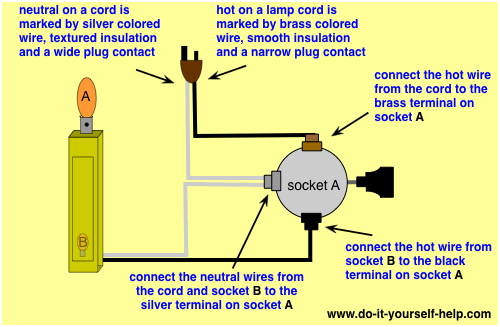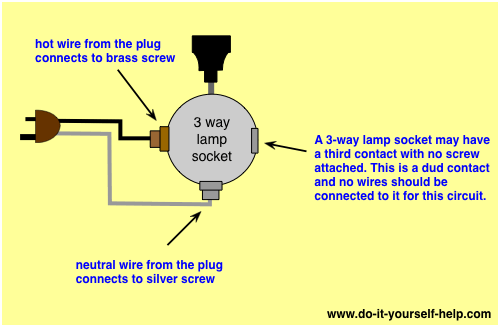Lamp Switch Wiring Diagrams
by: Dale Cox
Check permit requirements before beginning electrical work.
How to read these diagrams.
This page contains wiring diagrams for four different types of household lamps. Included is a diagram for a two-circuit lamp switch to control a standard lamp socket at the top of the lamp and a smaller socket at the base for a low wattage bulb. Also included are diagrams for a standard lamp switch, a three way lamp switch, and a vintage floor lamp with 4 light bulbs.
Finding Lamp Cord Polarity
Lamp cords are usually all one color making the standard black-hot, white-neutral guidelines useless for determining polarity. Other methods are therefore used to determine the polarity on a lamp cord. First, check the insulation on the cord wires closely and you will find either a textured bead or a thin colored line running along one wire, this is the neutral wire. The plain wire is the hot.
If the cord isn't marked with a bead, then the strands of wire may be different colors to distinguish between them. In these cases, the silver-colored wire is usually the neutral and the brass-colored wire is the hot.
Another clue to polarity is the plug on the lamp cord, the wide prong being the neutral and the narrow one the hot. Most older lamp cords will have prongs that are the same size. This is because polarity was not observed on electric lamps until the development of grounded circuits. With these lamps, the plug can be plugged into the receptacle outlet in either direction making polarity a non-issue.
Wiring a 2 Bulb Lamp Switch

This diagram illustrates the wiring for a bedside lamp with two sockets. The top socket A, holds a standard incandescent bulb. The second socket B, typically holds a small, low-wattage bulb similar to a night-light bulb. The switch allows for energizing the top bulb only, the night-light only, both bulbs at once, or for turning both bulbs off. This type of switch will be referred to as a 2 circuit lamp switch when shopping at home stores. Don't mistake this for a three way switch (pictured below), the two do not function in the same way.
Wiring a Push-Button Two-Lamp Switch

Here a 2-way push-button switch is wired to a lamp with 2 bulbs. This diagram can be used to rewire an old push-button lamp with a new switch replacement. The hot wire from the cord is connected directly to the black wire on the switch and the neutral is spliced to the neutral contact on each bulb sockets. The red and blue wires from the switch are each connected to the hot contact on one of the bulb sockets.
Wiring a 3 Way Lamp Socket Switch

This is a wiring diagram for a standard 3-way lamp switch. The socket is used with a three way bulb containing 2 separate elements that are energized separately and then together as the switch knob is turned for varying degrees of light. These sockets have two terminals, one for the hot wire and one for the neutral. A third contact may be present but is not used for this circuit.
Wiring a Single Lamp Switch

This diagram illustrates wiring for a standard, one setting lamp. This socket has two terminals: the brass for hot and the silver for the neutral wire. The lamp cord is connected directly to these terminals observing the polarity described at the top of this page.
Wiring a Vintage Floor Lamp Switch with 4 Bulbs

This is a wiring diagram for a vintage floor lamp with 4 bulbs, one main bulb and 3 peripheral, and usually smaller, bulbs. The main bulb threads into a standard socket with an integrated switch and the three peripheral bulbs are wired to a single switch usually located near the central socket. The secondary switch may have wires colored black, blue, and red or if it's an old switch, other colors or texturing may be used to distinguish them.
In this lamp wiring, the neutral wire on the cord is spliced to wires running directly to the neutral terminals on all four sockets. The hot wire from the cord is spliced to a wire running to the hot terminal on the primary socket A and to the hot wire on switch B. Switch B will have three wires, one for the hot source and two for connecting to the bulbs. One of these will connect the the hot on 1 bulb and the second will be spliced to the hot on the other two bulbs.
With this lamp, bulb A can be turned off and on independently and switch B can turn on bulb 1 alone, bulbs 2 and 3 together with bulb 1 off, bulbs 1, 2, and 3 all on at the same time, or all three off.
 Doorbell Wiring Diagrams
Doorbell Wiring Diagrams Circuit Breaker Wiring
Circuit Breaker Wiring Wiring for Two Outlets in One Box
Wiring for Two Outlets in One Box Making a Pigtail Splice
Making a Pigtail Splice Calculating Circuit Load
Calculating Circuit Load Home Electrical Glossary
Home Electrical Glossary